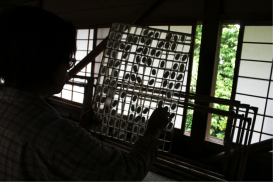This project examines how endeavors in Japan to produce and export mass quantities of raw silk generated new biological knowledge about the domesticated silkworm. A critical analysis of silk-craft practices shows how both genetic principles and industrial quantities of cocoons were products of distinct material transformations in the art and science of silkworm breeding. Attention to the technological, biological, and environmental construction of the lucrative cocoon, the source of raw silk filaments, shows how human choreography around an insect underpinned Japan’s industrialization from the 1850s through the 1940s. Various factors had contributed to Japan’s domination of 80 percent of the world’s silk market by the 1930s. Debates about how to improve and standardize Japanese silk led scientists working in imperial universities and industry to investigate laws of biology as they studied what exactly determined the qualities of the silk cocoon. One of the central figures in my study published the earliest known example of Mendelian genetics in an animal while experimenting on silkworms across many settings: an imperial university, a sericulture school, in Thailand, and the Japanese government. In addition, the regime of scientific and rational production at that time mapped upon desires to make Japanese silk superior to silks from China or Europe, which prompted the articulation of what counted as either a hybrid or pure biological type. Efforts to purify, test, and improve various “races” of the metamorphosing insect facilitated the displacement of local varieties as the crossbreeding of inbred strains of silk moths to make profitable hybrid cocoons with standardized features gained popularity. Biological knowledge hinged to the export silk industry and market fed a discourse of Japanese archipelagic and imperial unity that fostered new sericultural practices and internationally minded scientific investigations of heredity as individual scientists imagined ways to secure Japan’s place in the world. Based on archival and bibliographic research in private collections, laboratories, and libraries spanning from northern to southern Japan (Tokyo metropolitan area and Fukushima, Ibaraki, Gunma, Nagano, Shizuoka, and Fukuoka Prefectures), Thailand, the United States, and Taiwan, as well as interviews and hands-on experience in sericulture, a history of silk is retold as a history of how an animal was built to create economic and biological value during the nineteenth and twentieth centuries. The project will result in the publication of a monograph, tentatively entitled “Cocoon Cultures: The Entangled History of Biology and Silk in Modern Japan,” under contract with Duke University Press.

Artisan inspecting a frame of silk cocoons. Diverse sizes and shapes in this cohort of experimental hybrids point to the historical challenges that faced breeders and cultivators who sought to standardize the handiwork of silkworms.
Photo courtesy of Lisa Onaga
Project
(2016-)
